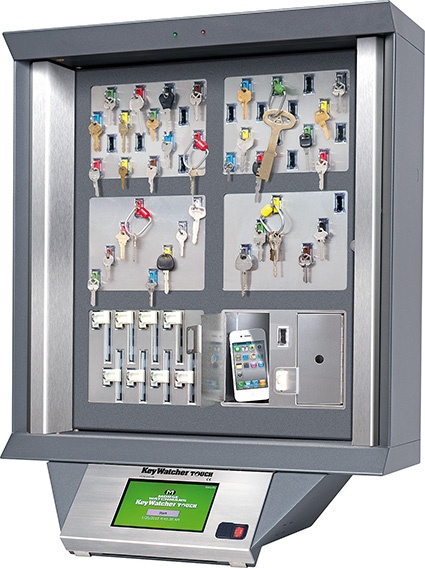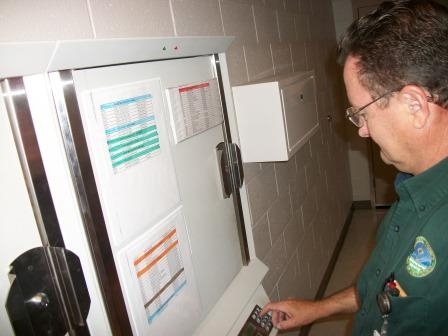Control of Key Possession Ensures High Security
At one time, keys were kept in boxes or drawers with little or no control over who had access to any given key. Even as security systems entered the digital and then the networked ...


At one time, keys were kept in boxes or drawers with little or no control over who had access to any given key. Even as security systems entered the digital and then the networked world, key control continued to exist separately from other system components and business operations. But as key control is one of the main components of effective access control and overall risk mitigation, it is essential for it to be part of an integrated system. Fortunately, technology developments and new products such as the KeyWatcher have made it possible to integrate key control as part of a facility‘s networked security system.
Key management systems can reinforce access control policies that are already in place and can also help to reduce the costs that are associated with lost keys or unmanaged access. It's also important to know that it is never too late - or for that matter, too early - to implement a key control and management plan as part of an overall physical security strategy.
Key control is especially important for end-user markets such as casinos and gaming, correctional facilities, healthcare institutions, hospitality businesses, multi-family buildings and educational facilities. It is also a critical function for anyone overseeing security at conference centers, government agencies, control rooms, automotive businesses and corporate buildings. These users always need to know who has possession of a key and when it was taken. They are markets that have a common need for complete control over their keys, with a system that seamlessly manages and monitors keys and that interoperates with access control and other security systems. However, key control can and should also be applied to all businesses of any size because of the measurable benefits of enhanced security, convenience, increased staff productivity and accountability.
System Interaction
Today, the most advanced key management solutions have open protocols to enable connectivity to access control and other systems provided by a range of integration partners. A system can be connected to edge devices via RS232 or networked via Ethernet. Critical information about key control can now be communicated across multiple systems, enabling additional security action to be taken. For example, a user who has taken a specific key can be denied egress from the facility until the key is returned - and selected management can be alerted via email if a key has not been returned on time.
A key control system with programmable software can enable system managers to establish permission levels for each user, as identified by an assignable PIN code that the user enters on a keypad, with additional access options such as biometric readers available to add another level of security. Managers can monitor data from any desktop connected to the network. Advanced software can run activity reports, sort activities based on various criteria, view and print reports, etc. System managers can generate practical management reports, which trace key movements by time, date and user code, with audit trail reports to indicate the time and date of each key accessed by a user for a given time parameter.
Lockers Too
Physical changes in a facility may also increase the need for a key control system. For instance, a closet that may have once been used only for storing office supplies may now be used for holding more valuable items and should be locked. In some cases, convenience for the security staff can even be substantially increased. For example, changes implemented over the LAN are effective immediately, which can help prevent incidents such as denying access to keys for recently terminated employees. The network connectivity of the system also allows management to remotely release any key, adding to the convenience and inherent safety provided by a key control and management solution.
Building on their widespread use and popularity as a security management tool, key control systems' functionality has been expanded to include custom modules and lockers that can accommodate plastic card keys or other valuable items. Lockers, available in various configurations, can be used for storing credit cards, small firearms, cell phones, two-way radios, laptop computers, tablets, cash trays and so on, and can be managed as efficiently as keys in key control systems.
Locker modules can easily be incorporated into existing key control systems or configured as stand-alone asset management systems. Their operation is identical to a key management system in that only pre-authorized users can access items in the lockers. Items can be returned to any open locker for convenience, and systems can be set up as a personal storage space for one or multiple users. The systems are also engineered to alert security management in case of an incident. An open door, the use of force to gain access, a power failure or even the misuse of the keypad will trigger an alarm and record the event in the log file.
Two Heads Are Better than One
Both key control and asset management systems can be customized with features that help the organization maintain the highest levels of security within their specific industry. To that end, addition al security features are available to help maintain the integrity of the system. For example, where protection of the key and asset cabinet itself is mission-critical, installation of a remote access device provides an additional layer of protection by enabling the locker system to be placed in a secure room. A second individual's PIN input and verification is then required in order for an authorized employee to access the contents of a locker. Many of these features are vital contributors to the maintenance of compliance standards for state or federal regulations as well.
All these advanced capabilities can revolutionize the function of key control, transforming it from its historical role as a separate function into its rightful place as a critical component of a cutting-edge security system.
Intersec · Hall SA · Stand 527C
Business Partner
Morse Watchmans2 Morse Road
CT 06478 Oxford
UK
most read

Integrated and Futureproof: Traka’s Next Chapter
Interview with Stefni Oliver on Traka’s Vision for the Future

Security management, building security & perimeter protection: the winners of category E at the GIT SECURITY AWARD 2026
GIT SECURITY AWARD 2026: Security management, building security & perimeter protection - an overview of the most innovative solutions

Is Your Venue Ready for Martyn’s Law?
Martyn’s Law demands stronger security by 2027. Is your venue prepared to protect and respond?









